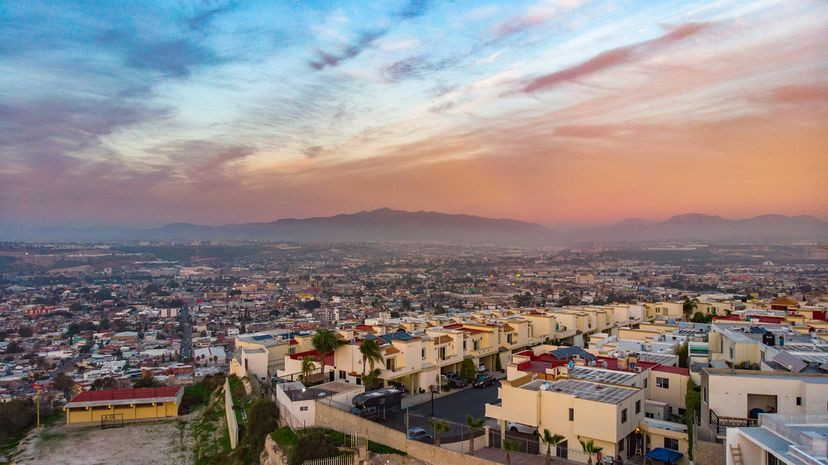Mexico, a vibrant nation of approximately 130 million people spread across 31 states and Mexico City, is a country often making headlines for violent incidents. It’s crucial to acknowledge that dangerous areas exist worldwide, and Mexico is no exception. This article will highlight some of the Dangerous Places In Mexico, focusing on cities grappling with high homicide rates, and delve into the factors contributing to this issue.
Over the past two decades, Mexico’s economic landscape has faced challenges while organized crime has expanded significantly. This growth is largely fueled by the lucrative illicit drug trade supplying markets in the United States and beyond. This expansion has unfortunately led to a surge in gang violence and other violent crimes across the country. Drug cartels frequently establish operations in cities strategically located along drug trafficking routes, particularly port cities and border towns adjacent to the United States.
To identify the most dangerous cities, we’ve analyzed data from a national heat map developed by Mexican data scientist Diego Valle-Jones. This map meticulously tracks homicide rates in Mexican cities, utilizing statistics compiled by the Mexican Justice System over the preceding twelve months.
Our analysis focuses on cities with populations exceeding 100,000 to avoid statistical anomalies that can arise from smaller sample sizes in smaller towns over short periods. The following list details cities in Mexico with the highest homicide rates per capita, offering insights into why these areas face such challenges.
1. Manzanillo, Colima (134 Homicides per 100,000 Residents)
 Cargo ships at the port of Manzanillo, Mexico, illustrating the city's importance as a major shipping hub and potential vulnerability to drug trafficking.
Cargo ships at the port of Manzanillo, Mexico, illustrating the city's importance as a major shipping hub and potential vulnerability to drug trafficking.
Manzanillo, a key shipping port in Mexico and a hub for domestic air travel, unfortunately ranks as one of the most dangerous cities not only in Mexico but globally. Its strategic location makes it a potential hotspot for trafficking through both local and international drug markets.
With a staggering homicide rate of 134 per 100,000 residents in a city of approximately 200,000, Manzanillo’s reputation has shifted drastically. Once a popular tourist destination renowned for its beaches and accessibility, the severity of violence in the Colima state region has prompted foreign governments to issue travel warnings against visiting.
2. San Luis Río Colorado, Sonora (128.5 Homicides per 100,000 Residents)
Located just south of Yuma, Arizona, and separated by the Colorado River, San Luis Río Colorado’s proximity to the U.S. border makes it a prime operational base for criminal organizations.
This border city faces a high violent crime rate of 128.5 homicides per 100,000 residents, nearly matching Manzanillo’s rate, within a population of around 209,000. The cross-border dynamics and trafficking routes contribute significantly to the violence experienced in San Luis Río Colorado.
3. Apatzingán, Michoacán (128.3 Homicides per 100,000 Residents)
 Cargo ships at the port of Manzanillo, Mexico, illustrating the city's importance as a major shipping hub and potential vulnerability to drug trafficking.
Cargo ships at the port of Manzanillo, Mexico, illustrating the city's importance as a major shipping hub and potential vulnerability to drug trafficking.
Unlike many other dangerous cities in Mexico, Apatzingán is situated inland, away from coastal areas and the northern border. Despite its historical significance as the place where Mexican independence from Spain was declared in 1814, Apatzingán today is unfortunately plagued by violence.
Apatzingán has become a battleground for competing drug cartels and a major hub for methamphetamine production in the region. The city’s homicide rate currently stands at 128.3 per 100,000 residents, serving a population of approximately 129,000.
4. Temixco, Morelos (115 Homicides per 100,000 Residents)
Temixco, a manufacturing center with a population of 126,000, carries a diverse history, including serving as an internment camp for Japanese immigrants during World War II. It also boasts proximity to historical monuments showcasing indigenous architecture.
However, Temixco has also become a hotspot for drug-related violence. The city’s homicide rate is reported at 115 per 100,000 residents, reflecting the impact of criminal activities on the local community.
5. Villa de Álvarez, Colima (114 Homicides per 100,000 Residents)
Villa de Álvarez, neighboring the state capital of Colima, shares similar challenges related to drug gangs as its sister city. This municipality is considered one of the most dangerous areas in the region.
With a homicide rate of 114 per 100,000 residents and a population of 158,000, Villa de Álvarez struggles with violence despite its economy primarily relying on fruit cultivation and shipping.
6. Cuautla, Morelos (113.1 Homicides per 100,000 Residents)
Cuautla, Morelos, holds a significant place in Mexican history, particularly during the Mexican Revolution of the 1910s. The region witnessed numerous battles between Emiliano Zapata’s forces and the federal army. Zapata himself was buried in Cuautla after his assassination in 1919.
A century later, Cuautla is again experiencing violence, with a homicide rate of 113.1 per 100,000 residents among its 192,000 inhabitants. This resurgence of violence marks a troubling chapter for a city steeped in history.
7. Yautepec de Zaragoza, Morelos (97.2 Homicides per 100,000 Residents)
Historically, Yautepec de Zaragoza, a former Aztec city, served as a frequent stop for Catholic missionaries. Known for its moderate climate, Yautepec is also a popular destination for local festivals and swimming.
Despite these positive attributes, Yautepec, like much of Morelos, is affected by crime. The city’s violence rate stands at 97.2 homicides per 100,000 residents, impacting its population of 108,000.
8. Tecate, Baja California (95.2 Homicides per 100,000 Residents)
 Cargo ships at the port of Manzanillo, Mexico, illustrating the city's importance as a major shipping hub and potential vulnerability to drug trafficking.
Cargo ships at the port of Manzanillo, Mexico, illustrating the city's importance as a major shipping hub and potential vulnerability to drug trafficking.
Tecate, similar to Tijuana, acts as a significant entry point into Mexico from California. It hosts diverse manufacturing industries, including textiles, metals, and plastics, and is famously home to the Tecate brewery.
As with other large border towns, Tecate grapples with drug trafficking and violent crime. The city’s population of 112,000 experiences a homicide rate of 95.2 per 100,000 residents.
9. Zamora, Michoacán (91.6 Homicides per 100,000 Residents)
Zamora is a popular destination for tourists and religious pilgrims, boasting well-preserved colonial-era Catholic architecture. Its economy is largely based on agriculture and cattle ranching. However, Zamora’s location between major Mexican cities like Morelia and Guadalajara also makes it a frequent site of gang violence.
The city’s homicide rate is 91.6 per 100,000 residents, affecting its population of 108,000. This violence contrasts with its cultural and economic importance.
10. Tijuana, Baja California (80.8 Homicides per 100,000 Residents)
Tijuana, Mexico’s second most populous city after Mexico City with over 2 million residents, is consistently listed among the most violent cities in the country due to its border location. The city’s homicide rate is reported at 80.8 per 100,000 residents.
Despite the violence, Tijuana’s robust job market in industries like automotive manufacturing continues to attract people. It also serves as a major entry point for Americans traveling into Mexico by land.
11. Acapulco de Juárez, Guerrero (74.7 Homicides per 100,000 Residents)
Acapulco, a coastal city south of Mexico City, was once a premier tourist destination in Mexico, famous for its luxurious resorts and cruise ship docks. Its Pacific coast location also established it as a significant shipping hub.
Unfortunately, recent years have been challenging for Acapulco. Drug cartels have established local criminal markets, and potential tourists are often warned against visiting this once-glamorous port city. The homicide rate in Acapulco is 74.7 per 100,000 residents, in a city of approximately 789,000 people.
12. Colima City, Colima (72.7 Homicides per 100,000 Residents)
Colima City, the capital of the state of Colima, features shipping ports and a nearby agricultural sector, making it economically relevant. However, these factors also create opportunities for criminal activity and drug cartel conflicts.
The city’s current homicide rate is 72.2 per 100,000 residents, impacting its population of 163,000. Colima City exemplifies how economic hubs can also become vulnerable to violence.
Understanding Violent Crime in Mexico
The homicide rate, a standard metric used by statisticians, represents the number of homicides reported per 100,000 residents within a year. This metric helps to compare levels of violence across different locations.
Nationally, Mexico’s homicide rate has fluctuated. After declining in the 1990s to levels comparable to the United States, it began to rise sharply around 2007. This spike may correlate with increased opioid and methamphetamine use in the U.S. The national homicide rate peaked in 2018 at 29.58 deaths per 100,000, and has shown signs of slow decline in the past five years.
A particularly concerning trend in Mexico is violence against women. The number of female homicide victims has increased disproportionately by 135 percent since 2015, highlighting a severe issue of femicide.
The primary drivers behind these homicide trends are believed to be drug trafficking, money laundering operations, and corruption within police forces, with allegations of organized crime groups exerting control.
While cities in Mexico frequently experience gang violence, it’s important to note that many rural areas in Mexico remain relatively safe from criminal gangs and drug cartel conflicts. The focus on urban centers in this list highlights the areas most impacted by high homicide rates, but does not represent the entire national landscape of safety in Mexico.
Sources:
- Britannica – Mexico
- Council on Foreign Relations – Criminal Violence in Mexico
- El Cri.men – Violence Map
- Britannica – Manzanillo
- HowStuffWorks – Most Dangerous Cities in the World
- LA Times – Travel Warning for Colima
- Britannica – San Luis Rio Colorado
- Britannica – Apatzingan
- Arkansas Online – Drug Cartel Violence in Apatzingán
- Data Mexico – Temixco
- Nuestro Stories – WWII Internment Camp in Temixco
- Data Mexico – Villa de Álvarez
- Indigenous Mexico – Mexican Revolution in Morelos
- ASU Digital Repository – Aztec City of Yautepec
- Baja California Tourism – History of Tecate
- Britannica – Zamora
- Mexico News Daily – Zamora Most Violent City
- Britannica – Tijuana
- Britannica – Acapulco
- Britannica – Colima
- Council on Foreign Relations – Mexico’s Drug War
- Vision of Humanity – Femicide in Mexico

